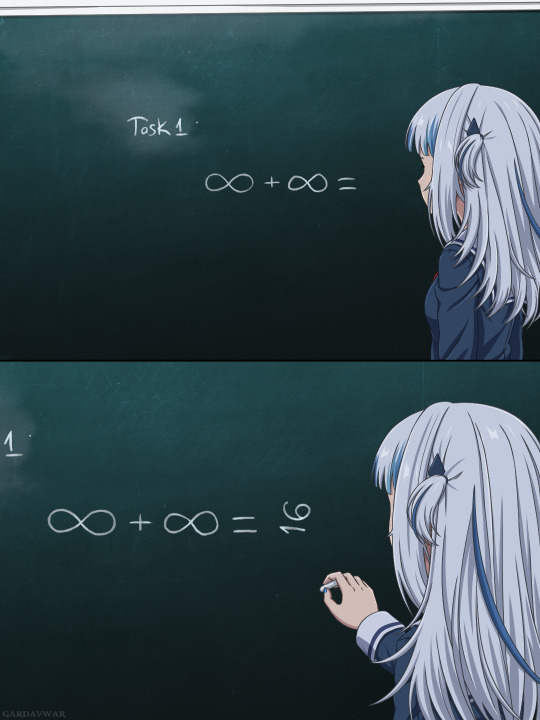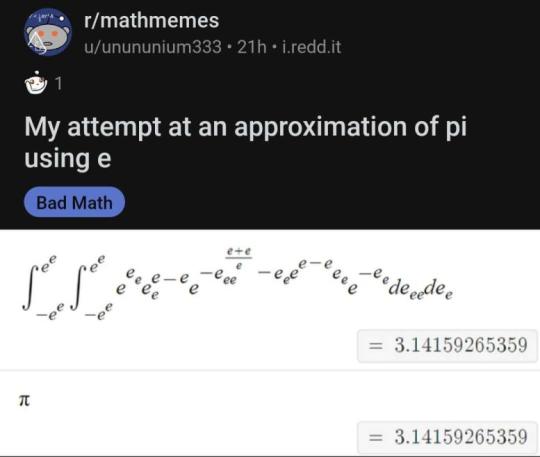Before you ask us a question, first check our FAQ and tags page to see if something similar has already been answered. If not, ask away! We can give you step by step explanations or any help at all in any aspect of maths you want. We're currently not looking for new admins! Administrative notes can be found here.
Don't wanna be here? Send us removal request.
Photo

working on something
2K notes
·
View notes
Note
Oh yeah? If you know numbers so good, solve 3x+1 then
I tried 8 and it immediately went back down to 1 so I’m pretty sure it’s solved. You’re welcome, Pythagoras
5K notes
·
View notes
Photo

Big Brain Time
12K notes
·
View notes
Text
#misc math#i'm pro cleo but i think it's fascinating to see that she's 'violated' an unwritted law#which is that forums are for suggesting an answer and explaining it
52K notes
·
View notes
Note
help! i feel like im going crazy!
my brother and i were watching an anime when a temperature of 39.2°C came up. being american, we only understand Fahrenheit. so, for fun, we decided to see if we could convert it in our heads...
needless to say, we couldnt and ended up looking it up. regardless, later i kept trying to work it out on paper. i finally remembered how, but..... it keeps coming out 1 off??? where am i going wrong! help!!

Hi :D ngl i'm kind of obsessed with your notes, bc you wrote the whole multiplication process down and then checked your answer. anyway let's get right to it:
in your multiplication table for 39.2 * 1.8, the first row is 39.2*0.8=31.36 (correct), and then you did 39.2*1.0=40.20. somewhere you added an additional 1 even though when you write it down like 39.2*1.0 you can see that the 40.20 can't be right.
i hope that helped!
also if you wanna know a temperature in °F but you can deal with a rough estimate, here's what i usually do:
1.8 is almost 2, or, in other words, it is 2-0.2. it's way easier to double a number in your head than do the whole "multiply by 1.8 ... argh how did that work again, i need a pencil" shtick. for the sake of simplicity, let's say you want to know what 39°C are in °F, so you could
multiply by 2: that's 78. an easy way to do this in your head is by calculating 40*2 and then subtracting 2, because 39=40-1, so 39*2 = (40-1)*2=40*2-2
keep the 78 as a preliminary result in your mind. now, shift the decimal one place to the left: 78.0 -> 7.8
subtract these: 78-7.8 = 70.2
now add the 32 and there you got your rough estimate of 39.2°C -> 102.2°F
when you shift the decimal place one to the left (or, divide by 10), you essentially calculate the result of 39*0.2. you could sum up this whole calculation as
39*1.8+32 = (40-1)*(2-0.2)+32 = 40*2-2-(40*2-2)/10 = 78-7.8 = 70.2+32=102.2
-sorrel
#ask#sketchious-anon#algebra#this really brightened my friday lbr i love handing out 'hacks' like these#when i was living in the UK the currency conversion was 1 pound = 1.2€ so all i did was multiply by 2 then shift the decimal then add#happy future anime watching. idk what 39.2°C was about but both body temperature and weather forecast are Bad News for this
3 notes
·
View notes
Note
A film starts at 6.40 it lasts 95 minutes what time does the film end
95 minutes = 60 minutes (1 hour) + 30 minutes (half an hour) + 5 minutes
6:40 + 1 hour = 7:40
7:40 + half an hour = 8:10
8:10 + 5 minutes = 8:15
3 notes
·
View notes
Note
Jolene invests her savings in two bank accounts, one paying 4 percent and the other paying 9 percent simple interest per year. She puts twice as much in the lower-yielding account because it is less risky. Her annual interest is 2941 dollars. How much did she invest at each rate?
We will need to use the formula for simple interest which is A = P(1 + rt), where P : Principal (initial investment) r : interest rate (as a decimal) t : time in years We will set up two equations and combine them to solve for P in both. For the low-yielding (which I will denote with “_low”), we have A_low = P_low * (1 + r_low * t_low) Similarly, for the high-yielding (which I will denote with “_high”), we have A_high = P_high * (1 + r_high * t_high) Now - what numbers do we get from the question?
We know: r_low = 4 % == 0.04 r_high = 9% == 0.09 t_low = t_high = 1 [year]
We also know that in the end, A_low + A_high = 2941. We also know that P_low = 2 * P_high (as Jolene invests twice as much into P_low as into P_high).
Can you set up the equations and solve it from here?
Here’s my solution:
A_low = P_low * 1.04 A_high = P_high * 1.09
A_low + A_high = 2941 = [P_low * 1.04] + [P_high * 1.09]
using that P_low = 2 * P_high
<=> 2941 = [(2 * P_high) * 1.04] + [P_high * 1.09]
<=> 2941 = 3.17 * P_high
=> P_high = 927.76 (rounded to the second decimal place, as we’re dealing with money)
=> P_low = 2 * P_high = 1855.52
- K
0 notes
Note
The Lines y = X² + 3x - 1 and Y = 2x + 5 intersect at two points. The lines joining the two points has length k√5. Find the value of K. (Hint; Use Pythagoras theorem to find the distance between the two points). I'm soooo confused, please help!! 😭💕💕💕
You can solve this in many ways but the easiest would be simple substitution with putting in y = (2x + 5) in for the left side of the first statement in the place of y.
This will remove y as being a variable and you can figure out x alone.
Which becomes
(2x+5) = x^2 +3x-1
5 + 1 = x^2 +3x -2x
6 = x^2 + x
0 = x^2 +x -6
And now we factor
(X+3)(x-2) =0
So our x intercepts are x= -3 and x = +2
Using either equation above given we sub in the X values to get our y coordinates
Ex.
Y = 2x + 5
[For x = 2]
Y = 2(2) + 5
Y = 9
So (2,9) is one intersection point.
[For x = -3]
Y = 2(-3) + 5
Y = -1
So (-3,-1) is the other point of intersection.
Set up the Distance Formula. The formula states that {\displaystyle d={\sqrt {(x_{2}-x_{1})^{2}+(y_{2}-y_{1})^{2}}}},
Now to find the k value you understand that you a^2 + b^2 = c^2 for pythagorean triangle so where your points intercept are the and b values.
So (2,9) is x1,y1
And (-3,-1) is our x2,y2
Use the distance formula and you will solve your problem.
I will let you finish this problem to help you practice. But leave the k solution at the bottom for you.
It seems long but its mostly practice. The more familiar you are with solving two equations the faster you'll handle all future problems :)
Good luck!
D = sqrt(125)
D = sqrt(25 *5)
D = 5* sqrt(5)
K = 5
0 notes
Note
3/5 + 7/8
Hi Anon! To add fractions, we need to get them to the same denominator (i.e. the number on the bottom of the fractions needs to be the same).
The lowest common denominator of 5 and 8 is 40.
So 3/5 = (3*8) / (5*8) = 24/40 and 7/8 = (7*5) / (8*5) = 35/40
Add these fractions: 24/40 + 35/40 = 59/40
- Kendra
1 note
·
View note
Note
The area is 3.0 meters with the radius being 17 meters inside and the outside radius is 20 meters. How many meters is required to form the area
Hi Anon,
if I interpret your question correctly, the problem is the following:

where r = 17 and R = 20, and we’re trying to figure out the area of the donut between those two radii.
We can do this by calculating the area of the big circle - area of small circle!
Area of the big circle: A = πR^2 = π * 20^2 = π * 400 = 1256.64
Area of the small circle: A = πr^2 = π * 17^2 = π * 289 = 907.92
Difference of the two areas: 1256.64 - 907.92 = 348.72
I hope this helps! If your question is different, feel free to send us another message to clarify :)
- Kendra
0 notes
Note
What percentage is 5 of 30?
5 goes into 30 exactly 6 times, i.e. 5/30 = 1/6. Thus, we have (5/30) × 100%= 16.666666667%
(if you mean 5% of 30, that would be
(5/100) * 30 = (5*30)/100 = 150/100 = 1.5
)
Hope this helps!
- Kendra
1 note
·
View note




